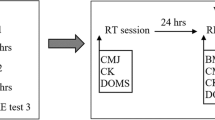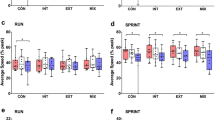Abstract
This study assessed the effects of exposure to cold (−14 and −9 °C), cool (−4 and 1 °C) and moderate warm (10 and 20 °C) environments on aerobic endurance performance-related variables: maximal oxygen consumption (VO2max), running time to exhaustion (TTE), running economy and running speed at lactate threshold (LT). Nine male endurance athletes wearing cross-country ski racing suit performed a standard running test at six ambient temperatures in a climatic chamber with a wind speed of 5 m s−1. The exercise protocol consisted of a 10-min warm-up period followed by four submaximal periods of 5 min at increasing intensities between 67 and 91 % of VO2max and finally a maximal test to exhaustion. During the time course mean skin temperature decreased significantly with reduced ambient temperatures whereas T re increased during all conditions. T re was lower at −14 °C than at −9 and 20 °C. Running economy was significantly reduced in warm compared to cool environments and was also reduced at 20 °C compared to −9 °C. Running speed at LT was significantly higher at −4 °C than at −9, 10 and 20 °C. TTE was significantly longer at −4 and 1 °C than at −14, 10 and 20 °C. No significant differences in VO2max were found between the various ambient conditions. The optimal aerobic endurance performance wearing a cross-country ski racing suit was found to be −4 and 1 °C, while performance was reduced under moderate warm (10 and 20 °C) and cold (−14 and −9 °C) ambient conditions.





Similar content being viewed by others

References
Bassett DR Jr, Howley ET (2000) Limiting factors for maximum oxygen uptake and determinants of endurance performance. Med Sci Sports Exerc 32(1):70–84
Bergh U, Ekblom B (1979) Physical performance and peak aerobic power at different body temperatures. J Appl Physiol 46(5):885–889
Bergh U, Danielsson U, Wennberg L, Sjodin B (1986) Blood lactate and perceived exertion during heat stress. Acta Physiol Scand 126(4):617–618
Blomstrand E, Essen-Gustavsson B (1987) Influence of reduced muscle temperature on metabolism in type I and type II human muscle fibres during intensive exercise. Acta Physiol Scand 131(4):569–574
Blomstrand E, Bergh U, Essen-Gustavsson B, Ekblom B (1984) Influence of low muscle temperature on muscle metabolism during intense dynamic exercise. Acta Physiol Scand 120(2):229–236
Borg G (1970) Perceived exertion as an indicator of somatic stress. Scand J Rehabil Med 2(2):92–98
Claremont AD, Nagle F, Reddan WD, Brooks GA (1975) Comparison of metabolic, temperature, heart rate and ventilatory responses to exercise at extreme ambient temperatures (0 degrees and 35 degrees C). Med Sci Sports 7(2):150–154
Craig EN, Cummings EG (1966) Dehydration and muscular work. J Appl Physiol 21(2):670–674
Faulkner JA (1980) Heat and contractile properties of skeletal muscle. In: Yousef MK, Horwath SM (eds) Heat, life and altitude. Thomas, Springfield
Fink WJ, Costill DL, Van Handel PJ (1975) Leg muscle metabolism during exercise in the heat and cold. Eur J Appl Physiol Occup Physiol 34(3):183–190
Flore P, Therminarias A, Oddou-Chirpaz MF, Quirion A (1992) Influence of moderate cold exposure on blood lactate during incremental exercise. Eur J Appl Physiol Occup Physiol 64(3):213–217
Galloway SD, Maughan RJ (1997) Effects of ambient temperature on the capacity to perform prolonged cycle exercise in man. Med Sci Sports Exerc 29(9):1240–1249
Gisolfi CV, Wenger CB (1984) Temperature regulation during exercise: old concepts, new ideas. Exerc Sport Sci Rev 12:339–372
Gonzalez-Alonso J, Mora-Rodriguez R, Below PR, Coyle EF (1997) Dehydration markedly impairs cardiovascular function in hyperthermic endurance athletes during exercise. J Appl Physiol 82(4):1229–1236
Greenleaf JE (1992) Problem: thirst, drinking behavior, and involuntary dehydration. Med Sci Sports Exerc 24(6):645–656
Helgerud J, Ingjer F, Stromme SB (1990) Sex differences in performance-matched marathon runners. Eur J Appl Physiol Occup Physiol 61(5–6):433–439
Kruk B, Pekkarinen H, Manninen K, Hanninen O (1991) Comparison in men of physiological responses to exercise of increasing intensity at low and moderate ambient temperatures. Eur J Appl Physiol Occup Physiol 62(5):353–357
Layden JD, Patterson MJ, Nimmo MA (2002) Effects of reduced ambient temperature on fat utilization during submaximal exercise. Med Sci Sports Exerc 34(5):774–779
Makinen TT, Gavhed D, Holmer I, Rintamaki H (2001) Effects of metabolic rate on thermal responses at different air velocities in −10°C. Comp Biochem Physiol A: Mol Integr Physiol 128(4):759–768
Nielsen B, Hales JR, Strange S, Christensen NJ, Warberg J, Saltin B (1993) Human circulatory and thermoregulatory adaptations with heat acclimation and exercise in a hot, dry environment. J Physiol 460:467–485
Oksa J (2002) Neuromuscular performance limitations in cold. Int J Circumpolar Health 61(2):154–162
Oksa J, Rintamaki H, Makinen T, Hassi J, Rusko H (1995) Cooling-induced changes in muscular performance and EMG activity of agonist and antagonist muscles. Aviat Space Environ Med 66(1):26–31
Oksa J, Rintamaki H, Rissanen S (1997) Muscle performance and electromyogram activity of the lower leg muscles with different levels of cold exposure. Eur J Appl Physiol Occup Physiol 75(6):484–490
Oksa J, Kaikkonen H, Sorvisto P, Vaappo M, Martikkala V, Rintamaki H (2004) Changes in maximal cardiorespiratory capacity and submaximal strain while exercising in cold. J Therm Biol 29(7–8):815–818. doi:10.1016/j.jtherbio.2004.08.063
Parkin JM, Carey MF, Zhao S, Febbraio MA (1999) Effect of ambient temperature on human skeletal muscle metabolism during fatiguing submaximal exercise. J Appl Physiol 86(3):902–908
Pate RR, Kriska A (1984) Physiological basis of the sex difference in cardiorespiratory endurance. Sports Med 1(2):87–98
Quirion A, Laurencelle L, Paulin L, Therminarias A, Brisson GR, Audet A, Dulac S, Vogelaere P (1989) Metabolic and hormonal responses during exercise at 20 degrees, 0 degrees and −20 degrees C. Int J Biometeorol 33(4):227–232
Rome LC, Loughna PT, Goldspink G (1984) Muscle fiber activity in carp as a function of swimming speed and muscle temperature. Am J Physiol 247(2 Pt 2):R272–R279
Rowell LB (1974) Human cardiovascular adjustments to exercise and thermal stress. Physiol Rev 54(1):75–159
Rowland T, Hagenbuch S, Pober D, Garrison A (2008) Exercise tolerance and thermoregulatory responses during cycling in boys and men. Med Sci Sports Exerc 40(2):282–287. doi:10.1249/mss.0b013e31815a95a7
Saltin B, Gagge AP, Stolwijk JA (1968) Muscle temperature during submaximal exercise in man. J Appl Physiol 25(6):679–688
Sandsund M, Sue-Chu M, Helgerud J, Reinertsen RE, Bjermer L (1998) Effect of cold exposure (−15 degrees C) and salbutamol treatment on physical performance in elite nonasthmatic cross-country skiers. Eur J Appl Physiol Occup Physiol 77(4):297–304
Selkirk GA, McLellan TM (2001) Influence of aerobic fitness and body fatness on tolerance to uncompensable heat stress. J Appl Physiol 91(5):2055–2063
Sparks SA, Cable NT, Doran DA, Maclaren DP (2005) Influence of environmental temperature on duathlon performance. Ergonomics 48(11–14):1558–1567. doi:10.1080/00140130500101254
Teichner WH (1958) Assessment of mean body surface temperature. J Appl Physiol 12(2):169–176
Therminarias A, Flore P, Oddou-Chirpaz MF, Pellerei E, Quirion A (1989) Influence of cold exposure on blood lactate response during incremental exercise. Eur J Appl Physiol Occup Physiol 58(4):411–418
Weller AS, Millard CE, Stroud MA, Greenhaff PL, Macdonald IA (1997) Physiological responses to a cold, wet, and windy environment during prolonged intermittent walking. Am J Physiol 272(1 Pt 2):R226–233
Acknowledgments
The authors wish to thank the athletes for their participation in this study, which was supported by the Research Council of Norway and the partners of the ColdWear project (http://www.sintef.no/ColdWear).
Conflict of interest
The authors declare that they have no conflicts of interests.
Ethical standards
The experiments comply with the current laws in Norway in which the experiments are performed.
Author information
Authors and Affiliations
Corresponding author
Additional information
Communicated by George Havenith.
Rights and permissions
About this article
Cite this article
Sandsund, M., Saursaunet, V., Wiggen, Ø. et al. Effect of ambient temperature on endurance performance while wearing cross-country skiing clothing. Eur J Appl Physiol 112, 3939–3947 (2012). https://doi.org/10.1007/s00421-012-2373-1
Received:
Accepted:
Published:
Issue Date:
DOI: https://doi.org/10.1007/s00421-012-2373-1



